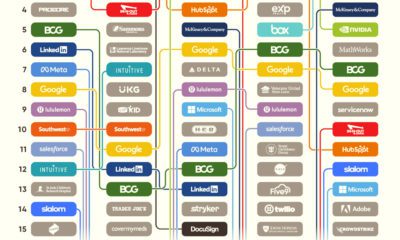While the automation potential of many jobs today is undoubtedly high, we also know that technology is going to create many new positions that we never could have imagined. Instead of fighting automation, the enterprising job seeker should consider being on the cutting edge by entering a field that is only just now emerging.
Popular Jobs in a Decade
Today’s infographic from Futurism shows just some of the jobs that may be very popular ten years from now.
Technology destroys jobs, but it also creates jobs. Many of the most interesting jobs in a decade from now relate to emerging technology trends: virtual reality, cybersecurity, the internet of things, vertical farming, big data, and more. Here’s descriptions of just some of these roles: Neuro-Implant Technicians: Dealing with brains is serious stuff, but working to insert implants is another level of complexity. We will not only need brain surgeons and people that can augment brains with technology, but we’ll also need people that can do backups of brain data as well as people that can interpret such data in real-time. Smart Home Handyperson: The smart home is a megatrend that will affect everything from your refrigerator to home security. We’ll need people who can connect these things together so that they work in unison. VR Experience Designer: Navigating virtual reality is going to be a challenge, and no one has really figured out how that’s going to work. We’ll need UX designers that can make this palatable for the average person, making VR accessible to everyone. Freelance Professors: Higher education as we know it is slowly dying. Professors in search of academic freedom are already leaving established universities to teach on a solo basis, and technology enables them to reach the masses. American historian Thaddeus Russell is a perfect example of this trend, establishing Renegade University to offer tuition at a fraction of the price. Urban Farmers: People want fresh food closer to them, and vertical farming is expected to gain momentum in the near future. We’ll need people that can teach the ways of vertical farming to new operations that emerge. Terabyters: You think big data is big now? In the near future, we will be capturing insane amounts of information through sensors, cameras, and other apparatuses. This will require special equipment and know-how. Nano-Medics: Technology has allowed us to dive deeper and deeper into the fundamentals of the human body. The most basic level is the cellular level, and we will soon have the ability to address concerns within this microscopic landscape. Nano-medics, essentially doctors that can diagnose symptoms, design treatments, and implement nanotechnology at a cellular level, will be needed. 3D Printing Engineers: The next wave of 3D printing technology will require engineers that can oversee and operate computerized plants that print everything from custom concept cars to biomaterials. Elevated Tube Transport Engineers: Vacuum tubes with maglev tracks will be the future’s trains. We will need people that understand how to solve problems that routinely occur with this emerging technology. Personal Health Coach: As the quantified self trend meets the cloud, we will seek professionals that can look and interact with our health data. They will provide us personalized solutions to make our lives better.
on But fast forward to the end of last week, and SVB was shuttered by regulators after a panic-induced bank run. So, how exactly did this happen? We dig in below.
Road to a Bank Run
SVB and its customers generally thrived during the low interest rate era, but as rates rose, SVB found itself more exposed to risk than a typical bank. Even so, at the end of 2022, the bank’s balance sheet showed no cause for alarm.
As well, the bank was viewed positively in a number of places. Most Wall Street analyst ratings were overwhelmingly positive on the bank’s stock, and Forbes had just added the bank to its Financial All-Stars list. Outward signs of trouble emerged on Wednesday, March 8th, when SVB surprised investors with news that the bank needed to raise more than $2 billion to shore up its balance sheet. The reaction from prominent venture capitalists was not positive, with Coatue Management, Union Square Ventures, and Peter Thiel’s Founders Fund moving to limit exposure to the 40-year-old bank. The influence of these firms is believed to have added fuel to the fire, and a bank run ensued. Also influencing decision making was the fact that SVB had the highest percentage of uninsured domestic deposits of all big banks. These totaled nearly $152 billion, or about 97% of all deposits. By the end of the day, customers had tried to withdraw $42 billion in deposits.
What Triggered the SVB Collapse?
While the collapse of SVB took place over the course of 44 hours, its roots trace back to the early pandemic years. In 2021, U.S. venture capital-backed companies raised a record $330 billion—double the amount seen in 2020. At the time, interest rates were at rock-bottom levels to help buoy the economy. Matt Levine sums up the situation well: “When interest rates are low everywhere, a dollar in 20 years is about as good as a dollar today, so a startup whose business model is “we will lose money for a decade building artificial intelligence, and then rake in lots of money in the far future” sounds pretty good. When interest rates are higher, a dollar today is better than a dollar tomorrow, so investors want cash flows. When interest rates were low for a long time, and suddenly become high, all the money that was rushing to your customers is suddenly cut off.” Source: Pitchbook Why is this important? During this time, SVB received billions of dollars from these venture-backed clients. In one year alone, their deposits increased 100%. They took these funds and invested them in longer-term bonds. As a result, this created a dangerous trap as the company expected rates would remain low. During this time, SVB invested in bonds at the top of the market. As interest rates rose higher and bond prices declined, SVB started taking major losses on their long-term bond holdings.
Losses Fueling a Liquidity Crunch
When SVB reported its fourth quarter results in early 2023, Moody’s Investor Service, a credit rating agency took notice. In early March, it said that SVB was at high risk for a downgrade due to its significant unrealized losses. In response, SVB looked to sell $2 billion of its investments at a loss to help boost liquidity for its struggling balance sheet. Soon, more hedge funds and venture investors realized SVB could be on thin ice. Depositors withdrew funds in droves, spurring a liquidity squeeze and prompting California regulators and the FDIC to step in and shut down the bank.
What Happens Now?
While much of SVB’s activity was focused on the tech sector, the bank’s shocking collapse has rattled a financial sector that is already on edge.
The four biggest U.S. banks lost a combined $52 billion the day before the SVB collapse. On Friday, other banking stocks saw double-digit drops, including Signature Bank (-23%), First Republic (-15%), and Silvergate Capital (-11%).
Source: Morningstar Direct. *Represents March 9 data, trading halted on March 10.
When the dust settles, it’s hard to predict the ripple effects that will emerge from this dramatic event. For investors, the Secretary of the Treasury Janet Yellen announced confidence in the banking system remaining resilient, noting that regulators have the proper tools in response to the issue.
But others have seen trouble brewing as far back as 2020 (or earlier) when commercial banking assets were skyrocketing and banks were buying bonds when rates were low.

















